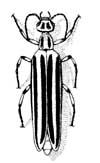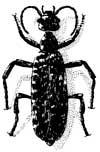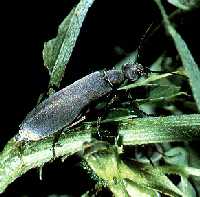by K.K. Kinney, F.B. Peairs and A.M. Swinker 1 (8/2010)
Quick Facts…
- Blister beetles produce cantharidin, a highly toxic chemical that irritates the gastrointestinal and urinary tracts and may lead to death, especially in horses.
- The larvae prey on subterranean grasshopper and bee eggs.
- Blister beetles in fields at harvest (swarming species) is a concern to producers.
- To manage blister beetles: harvest before bloom, do not condition hay in the bloom stage, and use registered insecticides prior to harvest if blister beetles are present.
Blister beetles or oil beetles are members of the family Meloidae. This family includes over 300 species in the United States and more than 2,500 worldwide. The genus Epicauta is the largest and contains many species that concern forage producers in semi-arid regions of the western United States.
Blister beetles produce cantharidin, which is toxic to people and animals. For centuries, cantharidin was prescribed as a cure for a variety of ailments. Spanishfly or cantharis, a preparation of dried meloid beetles, was thought to cure gout, carbuncles, rheumatism and many other medical disorders, in addition to its use as an aphrodisiac. Today, the toxic properties of cantharidin are more widely recognized and its use is largely restricted to veterinarians, who employ it as a counterirritant and blistering agent.
 |
 |
 |
| Figure 1: Blister beetles commonly found in Colorado alfalfa fields. Left: Three-striped blister beetle, E. occidentalis. Center: Spotted blister beetle, E. maculata. Right: Black blister beetle, E. pennsylvanica. | ||
Biology and Habits
Most species of blister beetles have one generation per year. Adults lay eggs in the soil. Larvae undergo several changes before overwintering as pseudopupae. First instar larvae seek out subterranean grasshopper egg pods (genus Epicauta) and bee eggs (genus Meloe) to complete the immature stages of development. Adult beetles are soft bodied with short wings. In some species, the wings do not completely cover the abdomen. In addition, their extended pronotum gives them the appearance of having a long neck (Figure 1).
Adults emerge from the soil throughout the growing season (May through September), but periods of peak activity vary with the species. In Colorado, E. murina and E. fabricii often are most abundant in June, while other Epicauta species are more abundant in July and August. After emergence, adult blister beetles are strongly attracted to alfalfa and other blooming hosts. Adult feeding generally is not significant enough to warrant intervention. However, certain blister beetle species, particularly the striped blister beetle (Figure 1) tend to congregate in swarms. The presence of such swarms in alfalfa at harvest is of concern to producers and horse owners because of the large amounts of cantharidin contained in these congregations.
Hay Conditioning and Poisoning
 |
| Figure 2: E. fabricii, a blister beetle common in June in Colorado. |
Blister beetles are a serious concern for hay producers and livestock owners. Cantharidiasis or blister beetle poisoning occurs when livestock eat hay that contains cantharidin. Cantharidin irritates the gastrointestinal and urinary tracts of animals and may lead to death. Although most deaths are reported in horses, cattle and sheep also are susceptible. Symptoms include blisters on the tongue and in the mouth, colic, diarrhea, blood or intestinal lining discharge in stools, and problems with urination or bloody discharge in urine. If blister beetle poisoning is suspected, contact a veterinarian immediately.
It is difficult to predict the number of blister beetles that will cause the death of an animal, because the cantharidin content of blister beetle species varies (Table 1). Moreover, male blister beetles have a higher concentration of cantharidin than females.
Modern hay harvesting practices (e.g., hay conditioners) are believed to increase blister beetle mortality so they are more readily incorporated into hay. In addition, cantharidin oil is released when adults are crushed and can contaminate hay even if the adult blister beetles are not present. Wheel traffic over mowed forage, crimping and cutting activity are the primary factors responsible for blister beetle death at harvest. Raking and baling have been shown to dislodge dead beetles from hay. Visual inspection of baled hay to detect blister beetles is difficult and will not reveal the presence of cantharidin oil.
Management
Blister beetles (Figure 1) are a concern to alfalfa producers throughout Colorado. The three-striped blister beetle, E. occidentalis, tends to be a localized problem in the southeastern Arkansas valley. Black blister beetle, E. pennsylvanica, and spotted blister beetle, E. maculataare more widespread. Several other species may also be present in alfalfa, including E. fabricii (Figure 2), E. murina, E. sericans, E. immaculata, Meloe laevis and M. niger.
Blister beetles that exhibit swarming behavior are of greatest concern because of the greater risk of a large number of beetles from the swarm getting trapped in a small amount of hay. Of the species mentioned above, the only swarming type is the three-striped blister beetle.
Because the larvae of many blister beetles in the genus Epicauta prey exclusively on grasshopper egg pods, these blister beetles are frequently associated with grasshopper outbreaks. Consequently, alfalfa grown near rangeland has a greater likelihood of blister beetle infestation.
Blister beetles are especially attracted to alfalfa and weeds (e.g., dandelion) during bloom. Consequently, reducing weedy host plants and harvesting prior to bloom are sound management tactics. First-cutting hay and later cuttings of hay (fourth or after the first frost) often escape contamination because they are produced before and after peak periods of beetle activity.
If blister beetles are present at harvest, using equipment without hay conditioners may help reduce beetle mortality and allow beetle dispersal prior to baling. This technique has been used successfully in Kansas and other midwestern alfalfa-growing regions. It may be of only limited use in semi-arid alfalfa-growing regions because of harvesting practices.
Insecticide for blister beetle control in alfalfa are available. See High Plains Integrated Pest Management Guide for details. However, since blister beetles may move into the crop at any time, the residual activity of the insecticide may not be sufficient to control blister beetles up to harvest. Also, Kansas State University recommends against the use of insecticides because blister beetles often leave the field after a short time and a chemical treatment would prevent them (and therefore the cantharidin) from leaving.
Insecticides are hazardous to pollinators, especially honey bees. Read, understand and follow all label directions, including pollinator protection statements.
| Table 1: A comparison of the relative toxicity to horses of three species of blister beetles. | |||
| Species | Estimated number of blister beetles required to cause mortality in a horse weighing: | ||
|---|---|---|---|
| 275 lbs. | 550 lbs. | 825 lbs. | |
| Black blister beetle | 550 | 1,100 | 1,700 |
| Spotted blister beetle | 175 | 345 | 520 |
| Three-striped blister beetle | 40 | 80 | 120 |
| Adapted from Capinera et al. 1985. J. Econ. Entomol. 78:1052-55. | |||
1 K.K. Kinney, former Colorado State University Extension entomologist and research associate; F.B.Peairs, Cooperative Extension entomologist and professor, bioagricultural sciences and pest
management; and A.M. Swinker, retired Extension horse specialist and assistant professor, animal sciences. The authors thank Lynne Rieske, Boris Kondratieff and Ian MacRae for helpful comments regarding the revision of this fact sheet. 6/98. Revised 8/2010.
Colorado State University, U.S. Department of Agriculture and Colorado counties cooperating. Extension programs are available to all without discrimination. No endorsement of products mentioned is intended nor is criticism implied of products not mentioned.
Go to top of this page.





